In-house Team Vs Remote Team Vs Dedicated Team Model: Which Is The Best Choice?
- Kevin Oskow
- January 16, 2020
- 9 Minute Read

The changing landscape of IT outsourcing has revolutionized the way businesses operate. The vital need to find a quintessential alternative to the in-house resources has given rise to offshore teams. In 2019, the global market size of IT services offshoring amounted approximately $92.5 billion. Furthermore, there is a momentous growth recorded in the digital offshoring value every year. But, does it mean a step back for the in-house team?
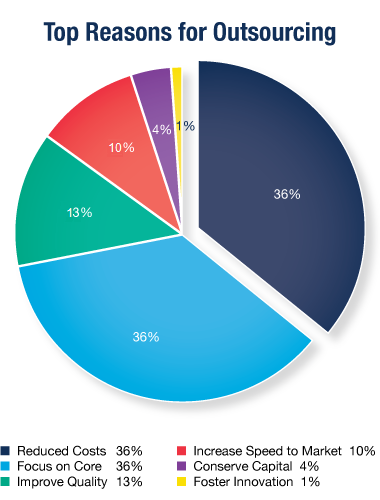
The business arena hints transition from the regular in-house vs outsourcing game. The Remote Team model and the Dedicated Team model are other promising contenders to keep an eye on.
The fleeting growth of IT services offshoring market from $45.6 billion in 2000 to $92.5 billion in 2019 is evidence of the fact that businesses are ready to leverage the alternatives to the in-house team model. But, does that mean that remote and dedicated teams are better options than the in-house team model? Let’s open the book of facts & reasons.
The main sections of the article include:
1. In-house Team Model
2. Remote Team Model
3. Dedicated Team Model
4. In-house Team Vs Remote Team Vs Dedicated Team: Comparison Table (Exclusive)
In-house Team Vs Remote Team Vs Dedicated Team Model: What to Choose?
In-house Team
What is In-house Team Model?
This model simply means utilising your in-house team for your projects. This is the most common model as it offers the CEOs maximum trust. A team that shares your vision and business goals. There is no better challenger in this game if your in-house team has the right skill-set.
Best Fits For?
‘All business types’ – Simple as it may sound, be it start-ups or large enterprises, every business type can have their best bet on their in-house team unless the team fails to deliver the right expertise and meet the company’s desired efficiency. In that case, in-house vs outsourcing comes into light.
Successful IT leaders, PayPal, Salesforce and Amazon depend on their in-house team for their development solutions. But, we have a list of pros & cons below to analyze which is better outsourcing or inhouse.
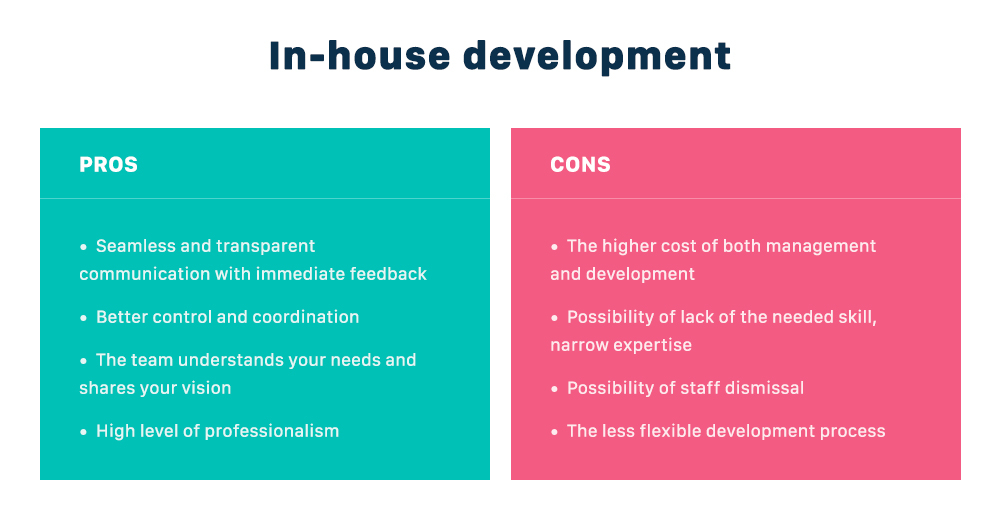
Pros of In-house Team Model
- Intellectual Property is Sheltered
Every business has its individual business processes, client data and intellectual property that if leaked is likely to cause the business a loss in its reputation, revenue, or client base. That is where a business can confidently depend on its in-house team. Amazon leverages its in-house team for most of the development tasks to protect its development secrets.
- Building Skills and Constructing Transferable Standards
Every business invests time, efforts and a certain amount of revenue in training its in-house staff for the right skillset. These skills are transferable in-house and can be utilized to build functional standards across the company. These standards can be followed by a new set of employees and the company saves on the training cost of new employees.
- Seamless Coordination and Efficient Management
The efficiency of face-to-face communication and seamlessly assisted operations cannot be compared with any other digital communication standards. The in-house team gives managers the right platform to polish their management skills, draw great productivity and offer quality solutions. Conversely, remote team management has been a challenge for businesses. And PayPal extensively depends on its in-house team to offer the most superior quality solutions and products across the globe.
- Encouraging Personal Participation and Profound Team Ethics
Other than the sense of accountability, there is always a sense of pride when working on your company’s project yourself. This develops a sense of loyalty, as employees feel more involved and influential with the project. The feeling gives rise to superior work ethics and team spirit.
- Better Accountability and Planned Budgeting
‘Accountability’, certainly the first concern that shoots up the brain of every business owner when he considers drawing a line between in-house vs outsourcing. It goes without saying that the in-house team model offers better reliability than the remote or dedicated model. Furthermore, the business owner has a say in the salary of his/her in-house resources and can efficiently plan long-term budgeting.

Cons of In-house Team Model
- Long-term Overhead Costs
Every business is liable to prepare payroll for its in-house employees. The in-house team model generally offers long-term employment and the business is responsible to pay for its employees’ health insurance, extra-time benefits, meal and travel expenses, etc. Moreover, the added infrastructure cost and employee retention cost, add up to the investment.
- Lacking the Right Expertise
Certain geographies face a scarcity of the right talent when it comes to certain skilled business operations. Furthermore, most businesses excel in a single niche, which fades the versatility. This leaves businesses with the obvious option of offshoring. 83 Percent of recruiters have to invest an extensive deal of efforts in sourcing the right talent in-house.
- Scalability Requires Much More Time & Effort
Hiring the right talent in-house for a long-term basis requires extensive efforts and time from the recruitment team. The process can extend from weeks to months and doesn’t meet your urgent scalability goals.
- Paying Way Too Much
In tier 1 countries including the US, UK, and Australia, the cost of hiring skilled digital resources is way much higher than tier 2 and tier 3 countries. This may be due to the scarcity of the right talent or the high economy of tier 1 countries.
Remote Team Model
What is the Remote Team Model?
A remote team model is defined as a type of outsourcing in which businesses hire several remote resources to build a distributed or remote team. So here, these are skilled resources with great expertise, and available at affordable costs. They work remotely and are dedicated to a client or business on a long-term contract basis.
Also Read: Exclusive Research on Why Remote Working is the Future of IT Industry
Best Fits For?
The model is preferred by clients who have a well-analysed project scope and progress with a clear vision of investment. Other than the cost benefits, the remote work model renders a well-proportioned list of benefits for a business.

Pros of Remote Team Model
- Increased Productivity
A remote team can increase work productivity by as much as 13% as compared to the in-house team. 2/3 of employers, report some increase in the productivity from their remote team as compared to the in-house team.
- Negligible to No Upfront Cost for CAPEX
“Office space is not cheap and start-ups need to find ways to save money, especially in the early days,” says Savage of GoShare. Costs like office furniture, electricity, business-level internet and other infrastructure facilities can be saved when opting for a remote team.
- Access to a Large Pool of Resources
Employers who invest in building remote teams are open to hiring talent from around the world. Owing to the scarcity of the right talent in a specific location, businesses prefer to opt for the remote work model. As the Gartner survey reports, 22% of the CIOs are unable to find the right skillset in-house.
- Finding the Right Expertise at the Best Price
When seeking for talent to join the remote team, employers look for candidates independent of their location. This allows employers to hire resources from tier 2 and tier 3 countries, allowing them to leverage the lower resource cost benefits as compared to tier 1 countries like the US, UK and Europe.
- Reduced Overhead Expenses Per Employee
A survey of 2018 reports, an estimated $5 billion in the upfront cost for U.S. companies who hired remote teams (part-time and full-time). With the remote team model, an employer is not bound to bear the cost of health insurance, extra-time benefits, meal and travel expenses, etc. for its employees. Cost remains an important parameter in in-house vs outsourcing decisions.
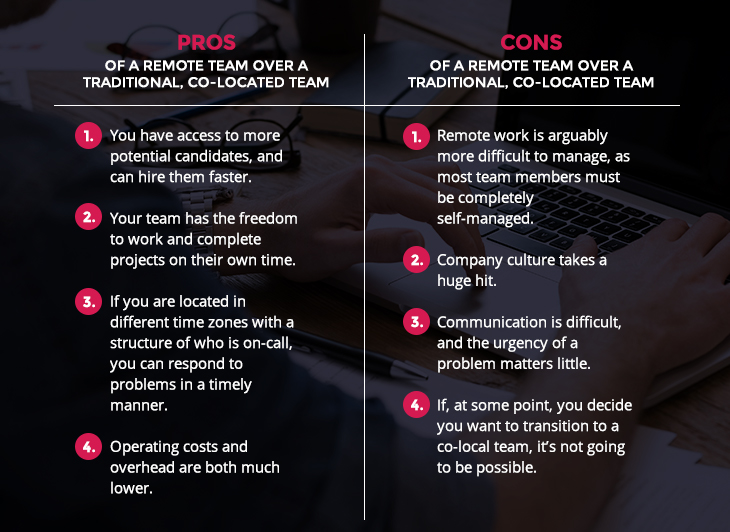
Cons of Remote Team:
- On-on-one Communication and Remote Team Management Becomes Tangled
The digital communication channels including phone, email, chat or video calls, cannot replace the efficiency of face-to-face communication. As a manager, it is hard for business owners to analyze the capabilities and managing remote workers. They need to push greater efforts in skill development and creating the right coordination among the member in the remote team.
- Scaling Isn’t as Easy as It Seems
Though remote team model, grants access to a large talent pool, finding the right workers to be added to your remote team remains a crucial challenge. The associated concerns include data security, time-zone management and reliability.
- A Cross-culture Gap Is Evident
Remote workers from different geographies, different time-zones and with no direct connection with the in-house team display a cross-culture gap. This can make remote team management a tough peak. However, start-up culture is more about shared values and goals.
- Risks Associated to Project Failure
Remote workers are generally self-employed experts who aren’t answerable to a parent agency and work on a contract basis with clients as full-time or part-time resources. Though these experts have a significant level of expertise and a reliable work portfolio, the risks associated to delay in timelines and project failure are higher.
Dedicated Team Model
What is the Dedicated Team Model?
As the name resembles, the ‘dedicated team model’ is about building a team of dedicated resources with the help of a specialised resource agency. This model of outsourcing is leveraged by large & long-term business projects. A perfectly-structured dedicated team is a good harmony of great skills, accountability, authoritative management and affordable costs. The model is constructive for clients having defined project-scope and business goals.
There is a list of pros and cons related to the dedicated team model, which are discussed below in the article.
Best Fits For?
Dedicated team model is the right choice for constant workload projects where the dedicated team is liable to serve a client in the same sense as his in-house team. It can help startups to cut down on the upfront costs of building a skilled team and help large businesses with their team expansion goals.
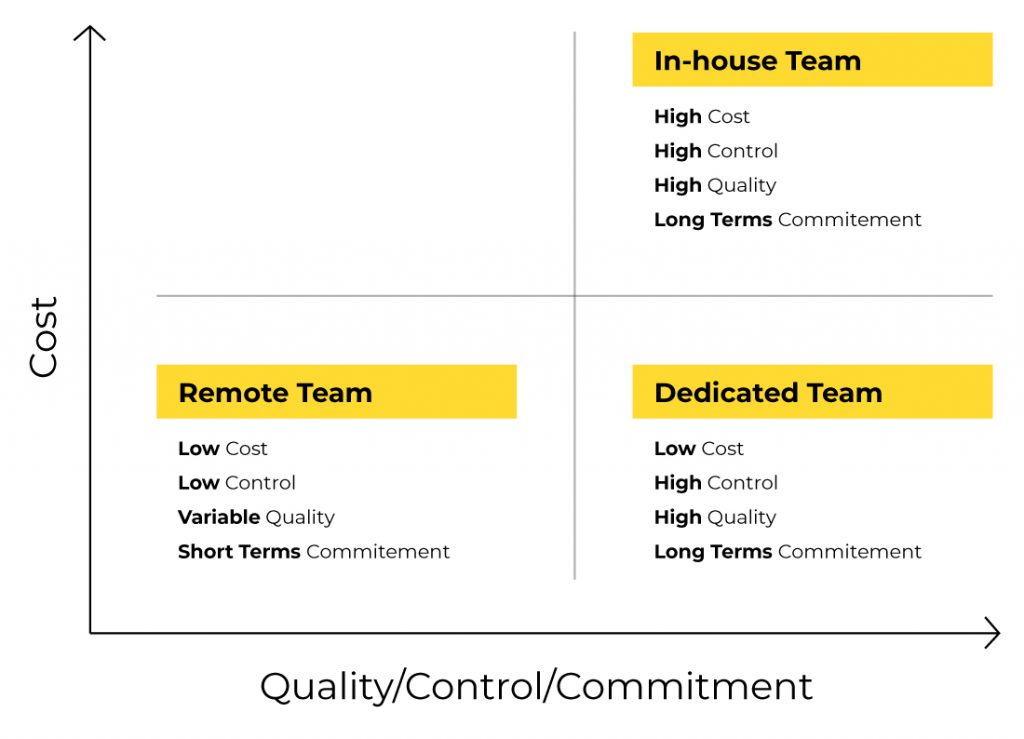
Pro’s of Dedicated Team Model
- Team Dedicated to Your Goals & Processes
Unlike a shared resource team, a dedicated team functions as a team of experts working full-time on your projects. You as a business owner can manage your team independently and align them according to your project and business goals. Some resource agencies grant businesses access to train their dedicated team at their premises and align them according to their processes and time-zones.
- Manage Team Structure and Scale On-demand
Large enterprises often prefer to choose the dedicated team model to meet their staff augmentation goals. Hiring a dedicated team from a specialized resource agency avails a business the capability to manage their team structure. The business owners can make quick calls about new additions to the team. Unlike managing remote workers, a dedicated team is more synchronized and the outsourcing vendor is liable to help you manage the team seamlessly.
- Build Team for Long-term Goals
A dedicated team serves the best for long-term projects and the same team working on a prolonged project avoids the hassle related to resource transition. Skills and standards developed across your dedicated team are transferrable and helps you in the long term.
- No CAPEX and Overhead Costs
Equivalent to the remote team model, the dedicated model helps save business owners from the CAPEX cost, including infrastructure setup, furniture cost, electricity and business level-internet. 44% of US businesses choose offshore development to reduce costs. Clients also save on overhead costs like healthcare insurance, free-time benefits, and meal expenses.
- Increase in Productivity
The Harvard Business Review claims that businesses experience a 10% increase in the average productivity from the dedicated development team model, without surpassing the budget. Moreover, businesses have access to a larger resource pool across the globe.
Also Read: Myths Associated with Hiring a Dedicated Web Development Team
Cons of Dedicated Team Model
- Cross-culture Gap
Though a dedicated team works in close coordination with the hiring manager at the client-side, it gets a narrow perspective about the company’s values and goals. This creates a cross-culture gap, which is likely to fade over time.
- Not Fit for Short-term Projects
Dedicated team model doesn’t fit right for short-term projects. Hiring a dedicated team for a short-term project (less than 2 months) may result in investing more time and finances as compared to the fixed time mode of outsourcing.
A Comparison Graph between Dedicated Team, Remote Team and In-house Team Model
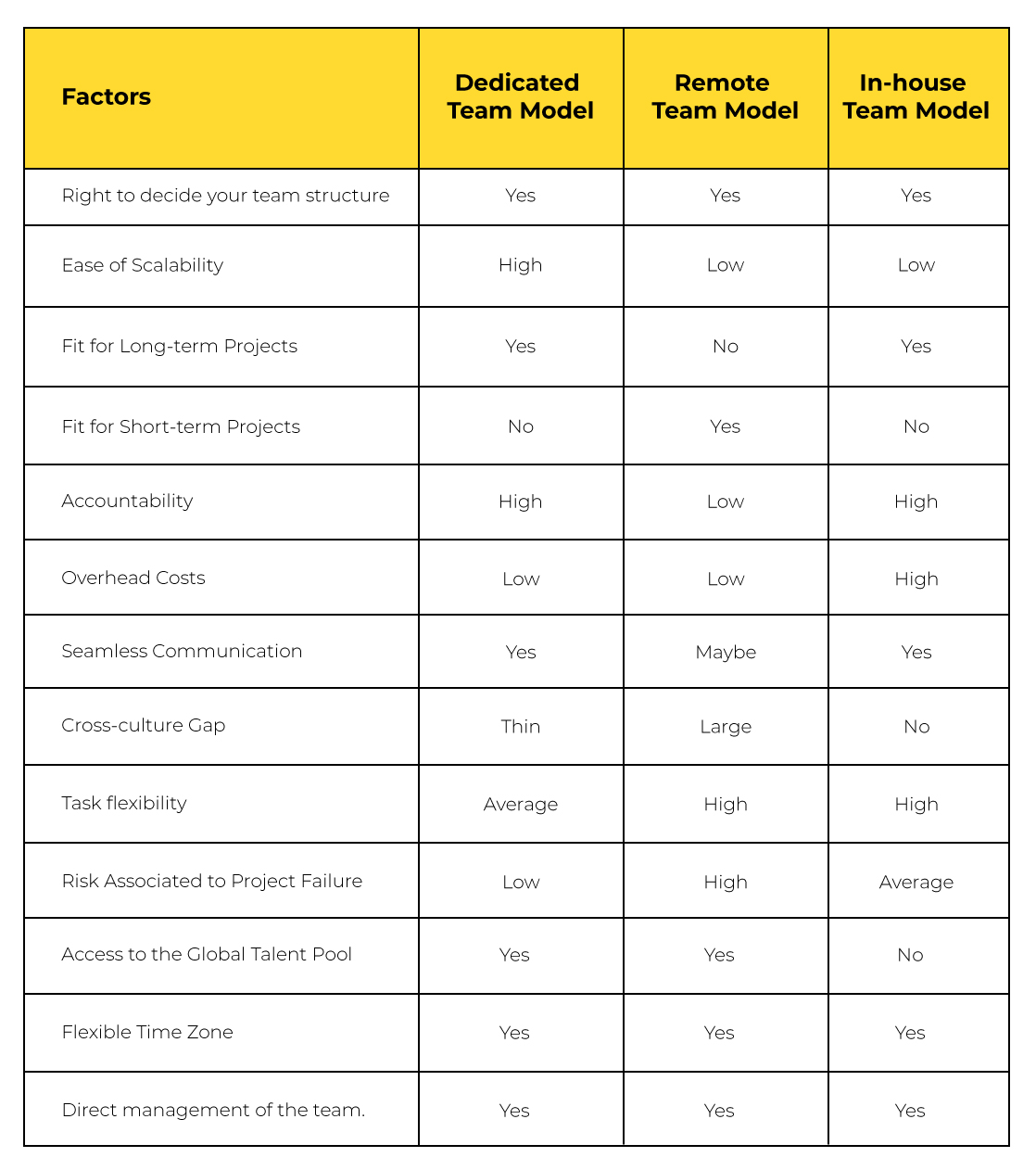
Summing Up
The Upwork projection states that by 2028, 73% of all teams worldwide will utilise the remote team model. Another parameter that puts the dedicated team model above the other models of outsourcing is that it combines the benefits of an in-house team model with the remote team model. However, there couldn’t be a better bet than the in-house team model, if your resources have the right skill-set and deliver the desired returns on investment. A business needs to scrutinize its goals and capabilities well before making a choice!



Thank you for submitting the details!
We will keep your information safe. Feel free to contact us with any questions at hello@uplers.com
Please check your email for next steps shared by Robert.



















